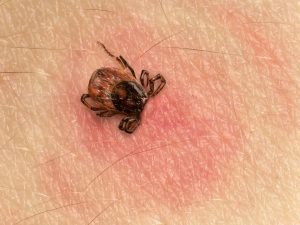Identification and Life Cycle
The three more common species of ticks are the American Dog Tick (Dermacentor variabilis), The Lone Star Tick (Amblyomma americanum), and the Blacklegged Tick, or Deer Tick (Ixodes scapularis). They possess a high potential for transmitting disease causing organisms to humans.
The American Dog tick is approximately 1/4 – inch long and is a light chestnut brown with a silvery-gray or creamy-white scutum.
The Lone Star tick is approximately 1/4 – inch long and reddish-brown in color. The female has a white dot or “star”, in the center of her back (shield).
The Blacklegged or Deer tick is less than 1/8 – inch long and are dark brown in color. Due to their small size, the attachment on a human can often go unnoticed.
All developmental stages (larva, nymph, and adult), require blood as a nutritive source. Its life cycle begins with an engorged female dropping off its host after a blood meal and completes digestion. She then develops a large cluster of eggs in a single mass, and dies shortly after. The larva emerges from the egg, and immediately finds a host. Once engorged with blood, the larval tick detaches its mouthparts, drops from the host, and molts to the eight-legged nymphal stage. The nymph then finds a host to feed upon, and once engorged, drops and molts to an adult.






Comments are closed.